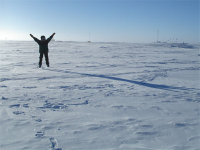The South Pole landscape is a vast expanse of gently sloping and relatively featureless ice and snow. Known as the Polar Plateau, the ice sheet extends in all directions for hundreds of kilometres before dipping in huge glaciers and ice streams towards the continental coast. Beneath the surface at the Pole, the ice extends 2700 m down to the bedrock of the continent. The whole ice sheet at the Pole is continually moving towards the Weddell Sea at a rate of around 10 m each year. This causes the position of the station buildings to constantly shift in relation to the geographic South Pole.
The ice sheet is a storehouse of past climate records and historic atmospheric conditions. Measurements of CO2 and other gases trapped in the ice allow scientists to reconstruct the historical composition of the atmosphere.

